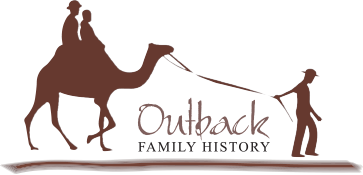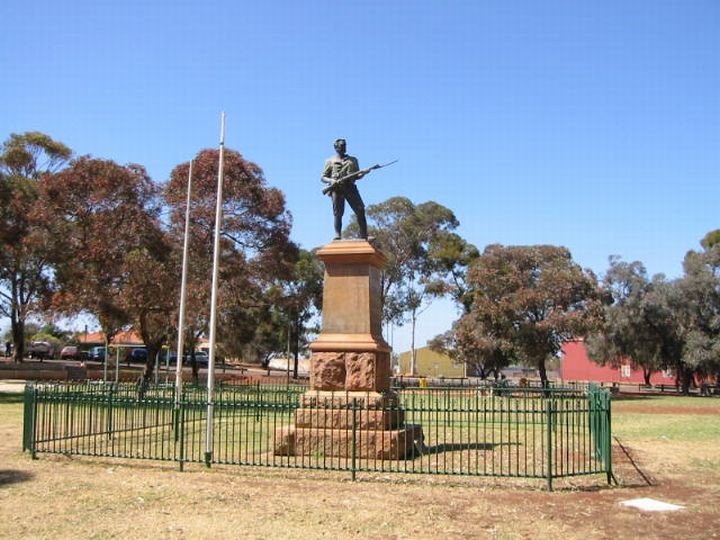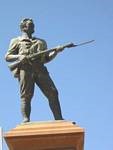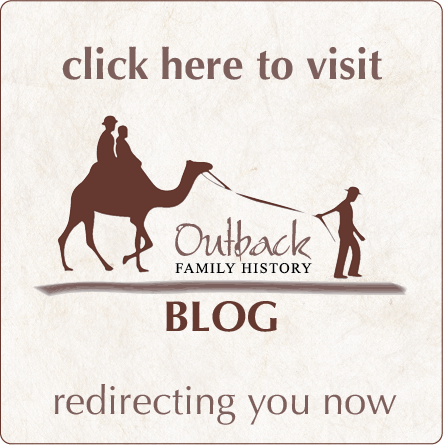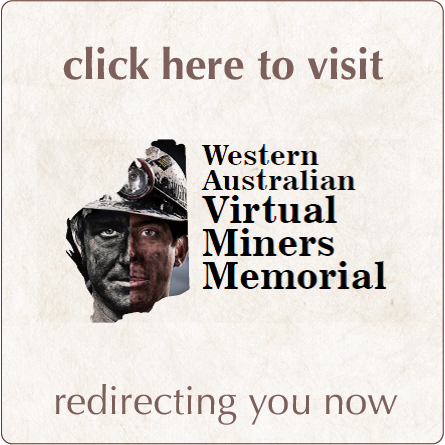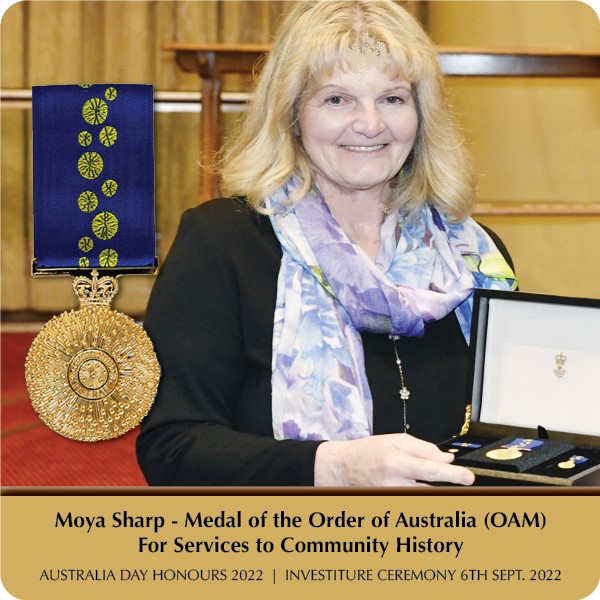- Aboriginal History
- Cemeteries
- Hospitals
- Hotels
- Maps of the Goldfields
- Military
- Miners
- Miscellaneous
- People
- Places on the Goldfields
- Place Index A-Z
This website is dedicated to the memory of my two dear friends Sandy Duncan and Shyama Peebles who both passed away in 2012.
Military > Boulder War Memorial
Boulder War Memorial
Place: Boulder, Western Australia, 6432
District:: Goldfields
Orientation: Part of Kalgoorlie-Boulder
Location: Railway Reserve, Hamilton Street in front of Boulder Railway Station
Position: 30 46 95S 121 29 53 E
Ref: 60012
__________________________
The memorial is a bronze statue of bare-headed soldier with an open-necked shirt, holding a bayoneted rifle and standing on a pedestal of Bulla Bulling granite. It rests on a granite plinth and a three-stepped granite base. The memorial is enclosed by a steel fence and there are three flagpoles on the north east side.
The monument was donated by David Donaldson, the publican of the Boulder City Hotel which is on the opposite side of the road from the Reserve. He requested that the statue be based on his son who had died of wounds in World War I. When found, the son was without his helmet so Mr Donaldson wanted the figure to be bare-headed with the shirt open at the neck. The memorial was sited to face the hotel. The model for this memorial and for the Kalgoorlie War Memorial was Private, later Major, Bill Hackfath. The sculptor was Pietro Porcelli and the monumental work was done by Baker and Mathews, monumental masons of Kalgoorlie.
The following description of the unveiling ceremony was printed in The Western Argus of 27 July 1920.
GOLDFIELDS SOLDIERS' MONUMENT
Unveiling Ceremony at Boulder
The monument donated by Mr. David Donaldson and erected in the Railway Reserve, Boulder, in honour of Goldfields' soldiers who participated in the Great War, was unveiled on 25th July, 1920 in the presence of a very large gathering. A portion of the reserve immediately surrounding the monument was set apart for the parents and widows of fallen soldiers, representative citizens, and those taking part in the service. There was a good muster of returned soldiers and cadets in uniform, others present including the Mayor and Mayoress (Mr. and Mrs. J. A. Rogers), the Town Clerk (Mr. E. W. Gribble), Boulder Councillors and their wives, the Mayor of Kalgoorlie (Mr. B. Leslie), the Chairman of the Kalgoorlie Roads Board (Mr. C. Brooks), Major-General Sir J. Talbot Hobbs and Lady Hobbs, Mr. Colebatch (representing the Government) and Mts. Colebatch, Archbishop Riley, Capt. Taplin (representing the State Commandant), Mr. J. Cornell, M.L.C. who also represented Mr. J. E. Dodd (absent through illness) and Mr. J. W. Kirwan (absent from Australia), Mr. A. L. Knowles (State Secretary of the R.S.L.), the President and Secretary of the Kalgoorlie R.S.L. (Messrs. H. Axford and W. A. Ross), Major Howard (Salvation Army). the Ven. Archdeacon Collick, the Revs. Canon Edington, H.H. Fennell, H. Carroll and R. R. Fleming, the Resident Magistrate (Mr. W. L. Owen), Capt. Nelson, Messrs. S. Beaton, J. Lyon Johnston and H. Waddell (three ex-mayors of Boulder), Mr. and Mrs. D. Donaldson and family, and others.
Mounted on a granite pedestal, 13ft. in height, the bronze statue presented an imposing sight. The figure is that of an Australian soldier, head bare and with the rifle gripped in fearless style. Inscribed on the monument are the words, "Lest We Forget. This monument is created in gratitude of the Goldfields' heroes who participated in the great War, 1914 - 1919, and in ever loving memory of those who died for Australia and the Empire. Their bodies are buried in peace, but their name liveth for ever more."
In his opening address, the Mayor, Mr. J. A. Rogers, expressed the thanks of the Citizens of Boulder to Mr. Donaldson and his wife for their magnificent donation to the town. In years to come, it would always bring back memory of the gallant boys who left these shores to fight for freedom and justice. Mr. and Mrs. Donaldson's son had left these shores, but unfortunately never to return. To them he offered the most sincere sympathy of the Citizens, and also to the other mothers, fathers, wives, sisters, brothers who were gathered there under similar circumstances. Whilst sympathising with Mr. and Mrs. Donaldson, he thanked them for the monument. Major-General Hobbs had played a great part in the war, and when deciding who should unveil the monument, it had been practically left to the soldiers themselves. Apart from his position of head military man in the State, he had no hesitation in saying that no man was held in higher esteem by the boys themselves than Major-General Hobbs.
After the assemblage had sung the hymns, "The Son of God Goes Forth to War" and "Nearer, My God to Thee", led by the Boulder Mines Band, a prayer was said by the Rev. H. Carroll, and Major Howard read the Lesson (Revelation xxi 1-5).
Major-General Sir Talbot Hobbs then presented 1914-15 medals to the following soldiers: J. J. Moore, M. Flannigan, G. Richards, W. H. Cooper D.C.M., W. Brearley, J. England, P. J. Cavanagh, B. J. Winzar, J. Stevens, J. Dunn and J. Golding.
Mr. Colebatch, on behalf of and in the name of the Government of the State, congratulated those heroes to whom Major-General Hobbs had presented medals so nobly won. He congratulated the people of Boulder on possessing such a splendid and enduring memorial to the bravery of the soldiers. The speaker touched on several phases of repatriation and referring to the Returned Soldiers League, expressed the opinion that the returned men were in a far better position than they could be without the league. For the next half a century, he concluded, the leaders of social and industrial life must inevitably be the men who went through the horrors of war and made Australia safe.
Archbishop Riley, who appeared in his uniform of Chaplain-General to the A.I.F., chose for his text the words: "Remember this, and show yourselves men". He said that no honour that could be given their soldiers was too great. The men had brought honour on Australia and added glory to the Empire. To his mind, the memorial was erected for three reasons. The first was to commemorate the heroes who died. It would be a very bad trait in their character if they did not always keep alive the memory of what the brave men had done. The next reason for the memorial was to show their sympathy to the friends of those who had sent boys to the front, and those who had lost their dear ones. Whenever he went home to England, he journeyed to a place to see a memorial put up to his father, and he had no doubt thousands of people would visit the reserve from time to time to see the monument to the brave deeds of their friends. As to the other reason for the monument, what they wanted in Australian History, was something to inspire them and in the monument they had it. It was just as hard to fight in times of peace as in times of war. He did not want them to go to war again, but he wanted them to fight bravely against all that was bad, mean, low and degrading. By putting up the monument, Mr. Donaldson had given an inspiration to the children of Boulder, which in future, would do incalculable good.
The monument was then unveiled by General Hobbs, and during the playing of the "Dead March" in "Saul" by the Boulder Mines Band, those present in the enclosure filed past the monument, upon which were placed numerous wreaths. Bouquets of flowers were presented to Lady Hobbs and Mrs. Colebatch by Miss Dethel Rogers, and were placed on the memorial. Mr. A. L. Knowles, State Secretary of the Returned Soldiers League, also placed a wreath on the monument on behalf of the returned soldiers throughout the State.
In the course of a brief address, General Hobbs said he knew the soldiers present would wish him to tell Mr. Donaldson he had done something for them and their fallen comrades which they would never forget, and for which they would ever be grateful. With regard to the men who fell, he knew what their ideas were, and knew they were prepared to make any sacrifice for duty. They gloried in their dying moments in having done what they thought was right for freedom and liberty. He hoped the memorial would serve to remind the people that war was not yet over, and that only by preparation could they avoid it. If they wished to show their gratitude not only for the dead but for the living, there was yet a lot to be done for the returned men. They were doing the best for themselves, and wanted no charity, but wanted sympathy, patience, help and advice.
It took more than months, more than years, for men who had gone through such dangers to get back to normal. As they honoured the dead, he hoped they would show gratitude to the returned men.
The sounding of "The Last Post", the Benediction by the Rev. H. Carroll, and the singing of the National Anthem concluded a most impressive service.
Archbishop Riley personally congratulated the bandmaster, Mr. V. Tatti, and the members of the Boulder Mines Band for the very excellent music provided by them, and his kindly act was deeply appreciated by the Bandsmen. "The Last Post" was sounded by Mr. J. Wallis, and the drum roll by the band drummers, Messrs. B. Crompton, senr, and junior.
West face
"LEST WE FORGET"
THIS MONUMENT WAS DONATED BY
DAVID C DONALDSON ESQ AND IS ERECTED
IN GRATITUDE TO THE GOLDFIELDS HEROES WHO
PARTICIPATED IN THE GREAT WAR 1914-1919
AND
IN EVER LOVING MEMORY OF THOSE WHO
DIED FOR AUSTRALIA AND THE EMPIRE
_______
THEIR BODIES ARE BURIED IN PEACE
AND THEIR NAMES LIVETH FOR EVERMORE
_______
DULCE ET DECORUM EST PRO PATRIA MORI
_______
Marble tablet at base
THIS MONUMENT
WAS UNVEILED BY
MAJOR-GENERAL SIR TALBOT HOBBS
1920
North face
Blank
East face
Three metal plaques
LEST WE FORGET
WORLD WAR II 1939-1945
KOREAN WAR 1950-1953
VIETNAM 1962-1973
Signature on north west base of statue
by Pietro Porcelli
Previous Record Boulder Roll of Honour |
Return to Military | Next Record Caledonian Soc Roll of Honor |
